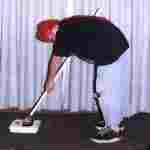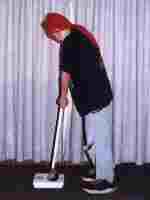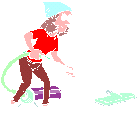BRUSHING equip. cont. Page 3.2--Brush Pole length and Efficient
Stance: Note brush handle length should be shoulder height. Note white
kneeslider. Click on kneeslider
to see the inconspicuous BLACK kneeslider.
Note brush handle length should be shoulder height. Note white
kneeslider. Click on kneeslider
to see the inconspicuous BLACK kneeslider.Note
student is pressing as hard as he can on a bathroom scale.

He is applying ONLY 30lbs. to the scale. The boy weighs 80lbs.
He says he is straining back and ham string muscles with the wide stance brushing
technique.
Stomach muscles are also tight. Back muscles feel like they are in a twist.
Arm muscles try to counter balance outward weight shift.
Left hand is pushing down very hard.
The right hand is pulling up which pushes on feet and not on brush head!!!
Brushing back and forth "pulls" arms and every other muscle harder and makes it
difficult to brush with high cycles.
Extra weight is applied to the toes in the counter balancing mode as pressure is applied
to the brush.
To make a long story short. You are working "heck" out of
the body while doing a poor high pressure brushing job! You are giving the engine of your
front wheel drive car lots of gas while applying the rear wheel emergency brake!
Why can't the boy apply more pressure in this body/brush application configuration?
The further out the stance, the flatter is the brush handle. The handle acts like a
"beam" instead of a "pogo" stick. In the beam scenario, force is
applied with the left hand at the middle. See boy's left hand. He pushes down with left at
center of "beam." What is his right hand doing? It is LIFTING up on the other
end to counter balance his admirable but somewhat useless effort!! What does this counter
balance force do? It pushes down on the feet and not on the brush shaft. This balance beam
brushing actually neutralizes most of your very hard work input. No wonder you couldn't
hold that delivered rock off the guard and hence lost The Worlds? You were pushing with
your left hand as hard as you could, but lifting on the right hand while
demonstrating to the TV camera man that you were working your bum off to help the team and
you were wasting your time.... Oh. My. I love physics! So, if the boy's total weight
of 80lbs. is applied to the left hand, 40lbs. of which is counteracted up with the right
hand allowing approximately 40lbs. to be applied to the ice. You are wasting a whole bunch
of energy for one half return. "Back to the drawing board and the peoples' tax
money," as they say at NASA, The National Aeronautics and Space Administration, as
another Mars Lander crashes.
I referred to a "pogo" stick. What does this toy have to do with physics and
curling? Well, the pogo stick applies 100% of energy in an almost vertical plane. So all
the energy you expended to get the thing to "pogo" goes back into the spring
and ground at impact for another bounce. Vertical application is the key! If you
don't believe me, get out the bathroom scale and do the experiment.
What else is the student doing in the next picture right and wrong?
Right:
1. He is looking at skip.
2. He is wearing grippers on both feet to:
A. Apply maximum pressure to brush without feet "kicking out" (may look neat on
camera) but reduces brush pressure and cycles.
B. Walk along side the rock when not brushing at a uniform speed with rock to consistently
judge rock speed. It is MUCH MORE difficult to judge rock speed with a slider on one foot
because: When wearing a slider, your body, inner ear, is constantly in an
acceleration/deceleration mode. That's right, as you push off to slide ahead, you
are accelerating and as the slide slows you are decelerating to again need another push
off. Your head "GYRO system," inner ear, is transmitting conflicting signals to
your mind which is trying to judge rock speed relative to the same ice sheet you are
scooting on.
3. He is brushing perpendicular to the the centerline. The brush head is parallel with the
centerline to allow maximum coverage with the small head high PSI (low area) brush. This
is the brush application necessary to apply "edge" of rock or
"short brushing" to the rock's 1/2 running surface path of 5" AND NO MORE.
Short brushing entails brushing 2-1/2 " and no more.
What 's he doing wrong?
1. The brush is on the wrong side of body to not allow square to the centerline brushing
without taking up a second brushers space (second brusher on same side maximizes edge
brushing) and allow a clear view of skip and rocks in play. If the brush was on the skip
side, the body assists the brush handle to move with the rock instead of wasting arm
strength.
2. The boy is not wearing a billed cap. If you spend 2 or more hours on the ice, there is
a chance of low level "snow blindness." Just think what that does to your
throwing and balance judgment. "Welding flash" is there whether you know it or
not and your eyes use 40% of brain capacity. Sorry ladies to cover your hair but are you
serious about winning or just curling for fun? You could of course put those black swipes
under the eyes like football players, if your sensitive about the hat issue?
3. The boy is not wearing warm apparel. Tremendous energy is lost in the 38F/5C
environment of curling if proper body energy conservation clothing is not worn. Save that
energy for brushing. Gloves may be necessary for some curlers but I prefer to deliver the
rock barehanded. The rock is an extension of your hand which is connected neurologically
to the brain so it is best to not have an insulator in the information path of ice to rock
to hand transmission conductor.
4. The boy is wearing summer low cut sneakers. I prefer the "high-top" over
ankle shoe with it's added warmth and ankle support. No one makes such a shoe that I am
aware of so the alternative is to have a comfortable set of high-top sneakers custom soled
with 1/4 inch Teflon slider AND the soft rubber gripper material applied to the hack shoe.
Order a corresponding gripper for the slider shoe so you can brush efficiently with two
grippers. The cost is worth it. You will find custom suppliers under the linksmaster web
page.
 NOW. Note student in the
upright position on brush. THE EFFICIENT POSITION. NOW. Note student in the
upright position on brush. THE EFFICIENT POSITION.
"Efficiency" in this case means: Most of the applied body weight is
transferred to the brushing surface AND the brusher is minimizing
muscle tension by applying muscle "pushing"/bone in-line
compression (muscles only work in tension). This translates to less muscle strain and
resultant fatigue and answers why I can "push down" on my brush 4 games in
one day and or 80 rocks should someone want to accept my challenge of a one on one 80 rock
brushing allowed curloff.
The factory 4' length brush is JUST long enough for the boy's 4'-6"
height.
The brush handle is just long enough to stick up past the arm pit to the back/shoulder
muscles.
If the brush was on the skip side, the upper body muscles would help push the brush
sideways in the same direction as rock travel
The body can "help" control the brush with large back
muscles. The
efficient brush travel distance is a stroke necessary to cover the 5" running surface
AND no more. A 6" swipe allows the 2-2 1/2" width of the brush to actually cover
the projected area of the 11-1/2 " rock such that any debris is not dragged back into
the rock sliding path. With the "soft" brush fabric cover head (not yet
manufactured), you can shorten the stroke more because all debris will be picked up and
remain on the brush fabric.
The pole is not poking and rubbing the arm pit. You will notice some European
curlers using a padded top piece to be able to push down harder utilizing the arm pit. I
have noticed that their pole is too short and they stand back too far nullifying most of
the actual downward pressure irrespective of the apparent hard work they are applying.
Also note that boy has a hole in the knee of his jeans. Probably the result of
his praying too much and his dad spent all their money on curling and can't afford new
ones.
WHY BRUSH AT ALL?
Why do we want to brush?

Just to give our skip an opportunity to vent his frustrations by yelling at us?
Well maybe, but more likely we "feel" we are helping our team by making that
dumb rock scoot further down the sheet, stop curl or INCREASE curl.
Proper brushing can be as important as skip rocks.
Brushing cleans the rock's travel path.
Some brushes are adept at picking up lint, brush hairs, and water impurities.
We are "sweeping" away larger broken pebble tops. Pebble is broken (sheared and
crushed) by rocks, hard fabric covered brushes and by sharp slider edges. Normal sliders,
those sliders without relief cut-outs, "curl" on the edges which for twisted out
foot slider curlers minimizes side shear and side force which pushes the curler off the
line of sight delivery. The disadvantage of a slider that "curls up" on the
edges is that much of the flat load bearing surface is reduced increasing the
"wobbly foot syndrome." Slider surfaces become curved after wearing which
reduces this shearing; however, the sliders that have round or rectangular
"cut-outs" to facilitate outer edge pressure cause more pebble shearing. Relief
style sliders, particularly oval/rectangular cut-outs introduce a resultant sideways force
which must be counteracted by the trailing leg and may result in x-firing the rock. All
you have to do to prove the FACT that relief sliders shear pebble for yourself is
slide the length of the sheet and then look/feel for the frost/chips in the relief
"hole" in your slider. Larger chips will fall out as you lift your foot and you
may not see them. I wear a "relief" round hole slider and I can
"feel" the ice shear vibration coming up through the foot as I slide on new
pebble. The round relief hole has rounded edges and does not alter my longitudinal sliding
forces since with my slide I follow the rock with a straight foot and my knee slider is of
the conventional flat style. Rounded outer edges of any slider will minimize pebble shear.
My slider is of the relief hole style (BalancePlus) and has maintained a more flat surface
in the ball of the foot area than a conventional slip on slider or glued on slider without
a relief cut-out so I figure it DOES work better for me. Then again my size 17 shoe size
does lend a certain natural stability anyway!!
Brushing's most important job is to crush "large" ice crystals
into small "water-like-acting" crystals resulting in less rock to surface ice
friction. A soft "faced" brush covering holds large and small crystals as can be
seen with the unaided eye and with high cycles and high pressure large crystals are
rubbed/ground one on the other into fine more "round" crystals so the rock will
slide easier. In addition, it is possible that the crystalline lattice structure of ice is
momentarily "bent flat" reducing friction (mechanical physical interlocking of
crystals) between the rock ice coated surface and the sheet ice.
Hard brushes can shear uneven pebble tops which is not good except in the first
two ends. You hear the "whining" sound of a clean hard nylon brush as it is
push-pulled back and forth. The idea is to NOT continually knock down/shave tops of
pebble, but smooth (crush large frost crystals) into molecular size crystals that ACT and
look (shiny) like a "water" lubricant film. This elusion is noticed after an
ice-skate makes a trail in the ice. This method of crushing large crystals into small
"water-like" crystals is maximized with a soft brush head fabric like wool
(duffel) and NOT harder/stronger than ice -- NYLON.
Soft Brushes polish the tops with the fine crushed crystals carried in the soft
cover (not hard nylon).
Small crystals are formed by the rubbing together of large crystals collected in the
fabric under" soft brushes."
It is important the large "rock grabbing" crystals in the "valleys"
between pebble are crushed as well.
The rock also rides in the valleys between pebble. The up and down motion can be heard by
the clicking/vibration sound as the rock slides down the sheet. Look in the technical
section- chapter "ice."
The two rock delivery taught in "The Book" not only is the ONLY proper way to
match rocks but allows comparative brushing.
 |
 Note brush handle length should be shoulder height. Note white
kneeslider. Click on kneeslider
to see the inconspicuous BLACK kneeslider.
Note brush handle length should be shoulder height. Note white
kneeslider. Click on kneeslider
to see the inconspicuous BLACK kneeslider.